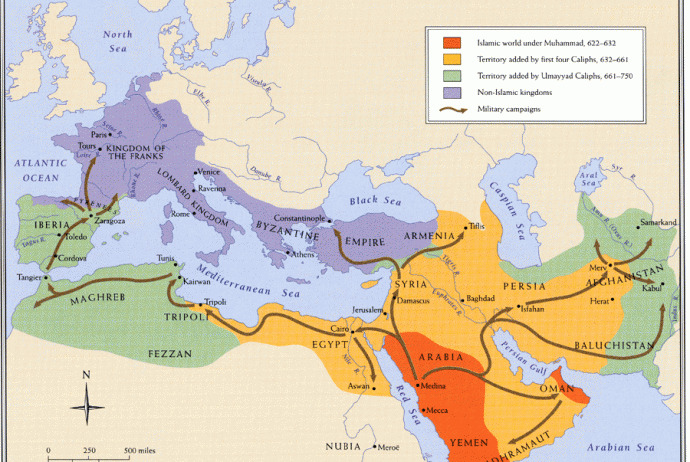The death of Muhammad in 632 AD initiated the infamous Islamic Conquest, in which missionaries traveled from Arabia across North Africa and into the Iberian Peninsula, educating locals on both the language and religion of the Arab World (Taha, 1989). The intent was to spread the language, specifically to enable more people to read the Qur’an and participate in public worship in what was considered “the holy language,” Classical Arabic. These evangelists quickly covered the African Mahgreb and reached southern Spain in the year 711 AD; their language and culture occupied this European country for more than six centuries (Taha, 1989).
Language contact of this magnitude between Classical Arabic and the Early Spanish of the eighth century had a grand impact on the Spanish vocabulary, an influence still prevalent today with common borrowings such as la almohada ‘pillow’ and alquilar ‘to rent’ among countless others all originating in Arabic. However, more than just borrowing an Arabic word and applying it within the Spanish language has happened in this inter-language transfer; the words were not simply maintained between the two idioms, but they were systematically altered to better suit the characteristics of the speaker and succumb to the distinct forms within the already regulatory Spanish language (Penny, 1991).
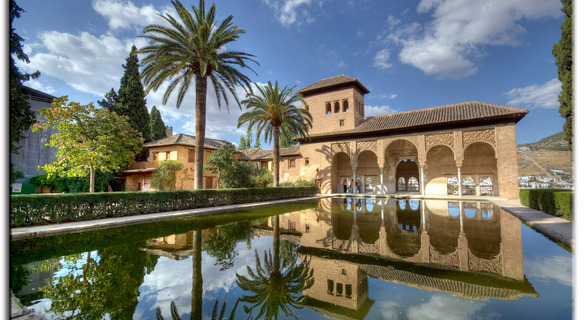
Spanish a modern descendent of the ancient Indo-European language and direct daughter of Vulgar Latin is linguistically distinct from Classical Arabic, of the Semitic language family, in its morphology, phonology, syntax, etc; but for the purpose of this writing, we will focus only on the Early Spanish phonology. With sound segments and systems so different from Arabic, Spanish speakers of this era had to adapt these borrowed words into something pronounceable within their own dialect which resulted in some interesting phonological patterns occurring within the bulk of the loan words. Due to our knowledge of Indo-European languages and the changes each underwent over time in order to form the modern languages we have today, scholars have been able to record the progression from ancient Proto-Indo-European to Latin to Spanish. This documentation allows us to rediscover a language existing within a certain time period through reconstruction, and study the sounds utilized within a language’s inventory at this very specific point in history. Through the careful compilation of scholarly works, we can get an approximation of what the early sounds of both languages looked like during this medieval era. From the year 711-1000 AD, the Spanish and Mozarabic (a Spanish influenced Arabic dialect spoken in Southern Andalusia) inventories would resemble something very similar to these charts:
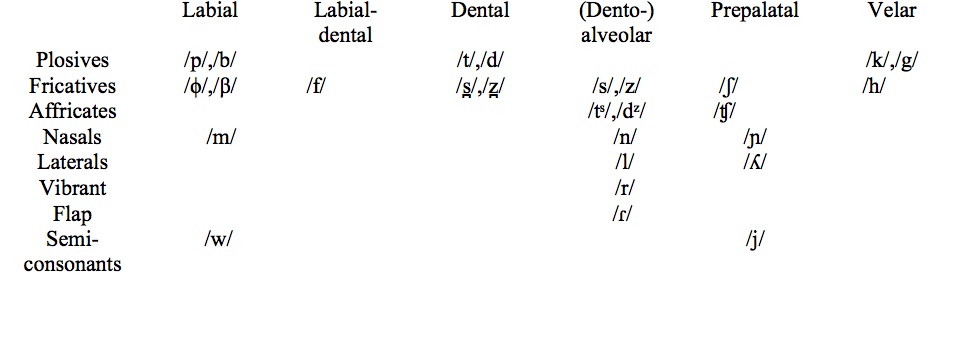
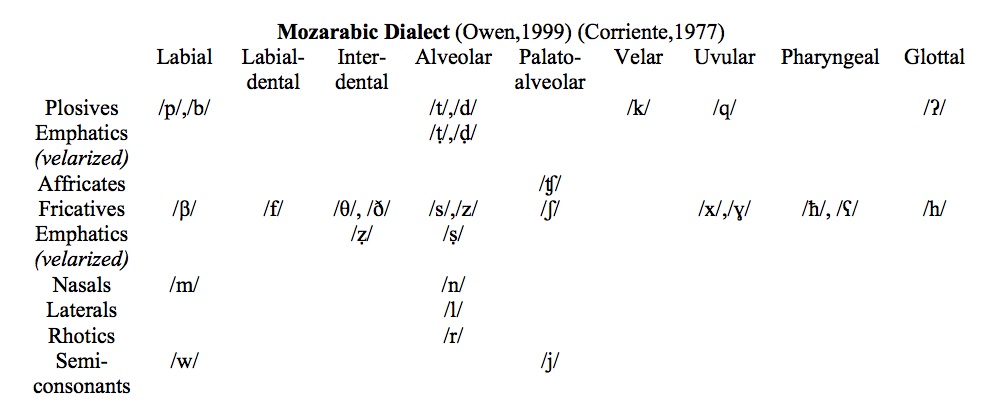
As you can see, the inventory of the Arabic language has more phonemes than that of Spanish (Watson, 2002). There are no phonemes in Spanish articulated further back in the mouth than the velum, or soft palate, but Arabic has uvular, pharyngeal, and glottal consonants; thus, we should expect alternations between varying segments unique to each language during the adaptation of borrowed words into Spanish. When words possessing these phonemes are adapted into Spanish, the language must produce some segment to compensate for the absence of the emphatics in its inventory.
For instance, the Arabic emphatics (i.e. /ṭ/, /ḍ/, /ṣ/, and /ẓ/, the emphatic version of /ð/) are segments articulated not only in their original place but also in the pharynx, or back of the throat, giving the phoneme a deep, guttural sound (Watson, 2002). In the case of the voiceless emphatics /ṭ/ and /ṣ/, these segments take the form of their voiced non-emphatic counterpart. Cases of shift from /ṭ/ to /d/ and /ṣ/ to /z/ are frequent within the data set: al-qúTun > algodón, baTiha > badea; al- qaSr > alcázar, al-maaSara > almazara. The transference of the voiced emphatics is a little less predictable. Generally, /ḍ/ will surface as the non-emphatic /d/ in such Spanish adaptations as aD-Dibbah > adivas and aD-Diyafa > adiafa; however, since the /ð/ phoneme was not introduced to the Spanish phonemic inventory until a later century, there is no non-emphatic counterpart for the /ẓ/, and for the lack of a phoneme closer in features, it will usually surface as /d/ as well: al-hanZal > alhandal.
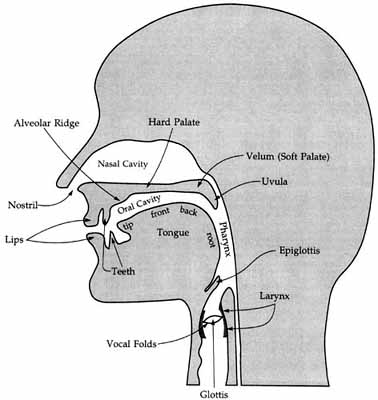
Besides the emphatics, there are at least two other guttural phonemes, not in the Spanish inventory, that must be adapted to fit the language within the data set beginning with the voiced uvular stop /q/. There are various surface forms for the adaptation of /q/ depending on the segment’s position in both the word and syllable. In the majority of the borrowed words, /q/ is replaced by the voiceless velar stop /k/: al-aqrab > alacrán, ilāqah > alahílca, ‘aqiq > alaqueca. This is no surprise since /q/ and /k/ share so many features in common (both are voiceless dorsal stops); the only changes actually occurring are [–high] and [+back] becoming [+high] and [–back], both being plausible since many other segments in the data set move forward in the mouth when transferring from Arabic to Spanish. On the other hand, while /k/ is the most abundant representation of original /q/ in the Spanish words, it is not the only segment that fills this position. Very often, when /q/ is in coda word final position, it will be deleted all together (a product of the Spanish syllable structure) when adapted into Spanish (zauraq > zabra); but this is not always the case as can be seen in the above example of ‘aqiq > alaqueca. In this case, vowel epenthesis occurred to move the /k/ into the syllable onset instead of the coda, but again, these are coping mechanisms relating to the Spanish syllable structure. In terms of phonology, /q/ seems to take form of three different segments when in an Arabic word borrowed into Spanish: /k/, Ø, and in other instances /g/.
Most cases where /g/ is the surfacing phoneme, it occurs between two vowels: al-baniqa > albanega, albershiq > albérchigo, al-buq > albogue. Intervocalic voicing is not foreign to Spanish phonology; thus, it is likely that the earlier phoneme is /k/ representing the Arabic /q/, and the /k/ became voiced between adjacent vowels. Of course, there are some exceptions as one can see with the example of ‘aqiq > alaqueca; it is difficult to determine the productivity of this, and there are many unknown elements that must be taken into account such as dialectal alternation. In addition, /g/ is usually reserved for the final onset within the data set, with some exceptions such as al-qúTun > algodón, where the /k/ is being voiced due to the influence of the following emphatic.
Coincidentally, the phonemes used to represent the voiceless uvular stop in the Spanish adaptations are the same as those used for the voiceless uvular fricative /χ/, with one exception. While /q/ normally became the phoneme /k/ when adapted into the Spanish lexicon, /χ/ (orthographically represented by kh-) typically surfaces as the phoneme /f/: al-khurj > alforjas, al-khilal > alfiler. This may be seemingly unusual since the two sounds are so different in place of articulation; however, during this time period, the Spanish language had three different allophones of /f/, therefore, the actual underlying /f/ rarely surfaced at all. Before the vowels /o/ and /u/, /f/ surfaced as the allophone [h], [hϕ] before /w/, and [ϕ] elsewhere (Lloyd, 1987). At least for the example of alforjas, this derivational rule offers some insight since the guttural /h/ is closer in place of articulation to the phoneme /χ/. As for other words in the data set, /χ/ may also appear as /g/ or /k/ depending on the surrounding environments: al-kharouba > algarrobo, al-manakh > almanaque. This change requires the same explanation as for /q/, these phonemes were the closest in distinctive features available in the Spanish inventory.
These examples of word borrowings and adaptations in the Spanish phonology are interesting because they uncover some facts about the early development of the language, which was a newly forming daughter of Latin; but also, this language contact demonstrates a historical connection between two distinct languages of diverse origin, Arabic being of the Semitic family and Spanish of the Indo-European. Perhaps this could be evidence for a preference for the wave model of historical linguistics over the tree model since the changes undergone by each language are not clear-cut and linear occurrences, but diachronic developments over time influenced by factors such as language contact from exterior cultures.
Written by Erica Mattingly
For Further Reading:
- Corriente, F. (1977). A Grammatical Sketch of the Spanish Arabic Bundle. Madrid, Spain: Instituto Hispano-Arabe de Cultura.
- Lloyd, P. (1987). From Latin to Spanish: the Phonology and Morphology of the Spanish Language. Philadelphia, PA: University of Pennsylvania.
- Owens, J. (1999). Arabic as a Minority Language. New York, NY: Mouton de Gruyter.
- Penny, R. (1991). A History of the Spanish Language. Cambridge, UK: Cambridge University Press.
- Taha, A. D. (1989). The Muslim Conquest and Settlement of North Africa and Spain. New York, NY: Routledge.
- Watson, J. C. E. (2002). The Phonology and Morphology of Arabic. New York, NY: Oxford University Press.
